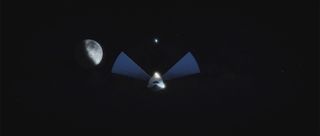
It looks like SpaceX's first crewed Mars mission will be an epic shout-out to one of the most beloved sci-fi novels of all time.
SpaceX plans to name the first of its many Mars-colonizing ships after "Heart of Gold," a spaceship in Douglas Adams' "The Hitchhiker's Guide to the Galaxy," company founder and CEO Elon Musk said Tuesday (Sept. 27).
"I think probably we'll name the first ship that goes to Mars 'Heart of Gold,'" Musk said during a presentation at the International Astronautical Congress (IAC) in Guadalajara, Mexico. "I like the fact that it's driven by infinite improbability, because I think our ship is also extremely improbable." [Images: SpaceX's Interplanetary Transport for Mars Colonization]
The Infinite Improbability Drive allows the fictional "Heart of Gold" — which looks like a giant, white sneaker — to cruise through every point in every universe at the same time. The drive is powered by a Bambleweeny 57 Sub-Meson Brain and a cup of hot tea.
During his IAC talk, Musk unveiled SpaceX's Interplanetary Transport System (ITS), the reusable rocket-spaceship duo with which the company plans to begin colonizing Mars within the next 10 years or so. ITS is the name of the overall architecture; each individual Mars-bound spaceship will presumably have a unique moniker.
Musk is a sci-fi fan, and he has named SpaceX vessels after ships in his favorite books. For example, the two robotic "drone ships" that serve as oceanic landing platforms for SpaceX's reusable Falcon 9 rocket are called "Of Course I Still Love You" and "Just Read the Instructions," two sentient starships that appear in the "Culture" series by Iain M. Banks.
If everything goes according to plan, thousands of ITS spaceships will eventually journey to Mars, transporting 1 million or so colonists. (These pioneers could come back home if they wanted to; each ITS spaceship would make multiple trips between Earth and Mars.)
Get the Space.com Newsletter
Breaking space news, the latest updates on rocket launches, skywatching events and more!
Musk said he'd like to go to the Red Planet someday, but he's not sure if he'll be aboard the history-making "Heart of Gold," which could launch as soon as 2024.
"I would definitely need to have a very good succession plan, because the probability of death is quite high on the first mission, and I'd like to see my kids grow up and everything — so, some pros and cons there," Musk said.
Follow Mike Wall on Twitter @michaeldwall and Google+. Follow us @Spacedotcom, Facebook or Google+. Originally published on Space.com.
Join our Space Forums to keep talking space on the latest missions, night sky and more! And if you have a news tip, correction or comment, let us know at: community@space.com.

Michael Wall is a Senior Space Writer with Space.com and joined the team in 2010. He primarily covers exoplanets, spaceflight and military space, but has been known to dabble in the space art beat. His book about the search for alien life, "Out There," was published on Nov. 13, 2018. Before becoming a science writer, Michael worked as a herpetologist and wildlife biologist. He has a Ph.D. in evolutionary biology from the University of Sydney, Australia, a bachelor's degree from the University of Arizona, and a graduate certificate in science writing from the University of California, Santa Cruz. To find out what his latest project is, you can follow Michael on Twitter.
